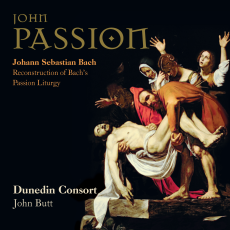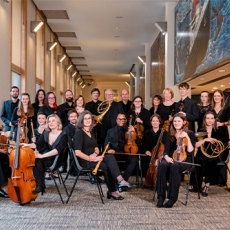John Passion - Dunedin Consort - International Record Review
The great musical works of art hang on the walls of our aural galleries emanating a deceptive sense of timelessness and immutability as if intentionally created only int he forms in which they are now generally known. In today's enlightened times we know better, of course. Interpretation and reinterpretation of the original texts lead to different types of performance and to variant forms of the works themselves.
Here we have two contrasting performances of the St John Passion: one, from Gary Graden with the St Jacob's Chamber Choir and the orchestra REbaroque, a record of a long tradition of performing the work at St Jacob's Church, Stockholm; the other, from John Butt and the Dunedin Consort, a conjectured performance of 1739. To imagine original context adds yet another interpretative layer, and a number of specialist groups now excel at this sort of musical construction. Butt's idea is to contextualize the St John Passion, carefully removing it from the gallery wall and setting it in a recreated Vespers service as it might have been celebrated on Good Friday in Bach's Leipzig. To experience the work as merely part of the liturgy is a salutary reminder of its original devotional purpose and helps to wipe away the marks of semi-secularization to which it has subsequently been subjected.
The organ preludes, motet, congregational hymns and sung prayers that in this reconstruction preface and fallow the two parts of the Passion help to articulate its themes and make musical connections. They support the Passion without distracting from it, and in turn the Passion amplifies and comments on the surrounding texts. For those who wish to observe the complete Passiontide liturgy, more than an hour of additional material is available to download from Linn's website, including the whole central section of the service with further music and a 40-minute Lutheran sermon from 1720 (in German) and ‘alternative' sermons from the musical and theological viewpoints of Butt and Richard Holloway. Together with the lengthy essay on the Passion and the reconstruction printed in the booklet, the whole enterprise is ambitious, radical and informative, a truly multimedia project of which the CD recording is just one element.
In the Dunedin performance of the Passion, the choral parts are sung by eight ‘concertists' and ‘ripienists' who constitute a strong, tight unit that responds quickly and subtly to the changing moods and functions of the ensemble movements. The distinctiveness of the separate voices is clearly apparent, and in the more dramatic episodes this sharply characterizes theme as a group of baying individuals rather than a single mob. If a downside of the few-voice approach is that the overall effect is flatter, with fewer gradations of scale than are possible with several voices to a part, the benefit must surely be that the intimacy contributes to a more intensely personal communication of the Passion's message, and that is entirely in keeping with the devotional intent of the reconstruction. All of the soloists are generally outstanding. Nicholas Mulroy's lithe, sensitive Evangelist is the epitome of narrative clarity and contrasts beautifully with the calming, authoritative richness of Matthew Brook's Jesus. A particular highlight is ‘Es ist vollbracht!', the exhausted desolation of its outer sections brought out superbly by Clare Wilkinson's veiled duskiness, itself a gorgeous counterpart to the drained, parched tone of the viola da gamba.
Over in Stockholm, the St Jacob's Choir of 30-plus singers is well drilled by, apparently located in some way behind the orchestra, suffers from a distant recorded perspective. The opening exclamatory ‘Herr, unser Herrscher' is round-edged, lacking the biting grip that is expected, and the effect of the movement is soft-focused and passive. There is also some slackness in the ensemble, particularly in those fast-paced sections of integrated recitative and chorus: ‘Bist du nicht?', for instance, jumbles in chaotically and takes a second or two to find its feet - dramatically fitting if not musically desirable. In places this must be a consequence of Graden's choice of tempo: he takes many of the turba choruses very fast indeed, and the often ultra-staccato delivery (of the ‘Kreuzige' choruses, for example) serves only to exaggerate an almost rabid sense of frenzy. The dramatic pace is breathless. The singers actually manage astonishingly well, but the speeds can be just too rushed to allow the often intricate orchestral parts to shine through. In the arias, too, the soloists are sometimes swamped by the orchestra: in ‘Von den Strikken' countertenor Mikael Bellini strains to be heard above his rather forward accompaniment. Although mostly well sung, with appropriate sensitivity to mood and meaning, the highest level of refinement can be lacking int he most demanding arias and passages of recitative, as excitement, anger and earnest sentiment give voice to untamed runs and overshot intonation.
Among various different choices made regarding instrumentation the two performances demonstrate contrasting ideas, in particular about the use of continuo instruments. Butt is the more conventional, favouring a simple, discreet group of organ and harpsichord as the harmony instruments with the usual string bass. Graden is bolder adding a plucked string instrument (lute) and, in recitatives that can seem a little overdressed, using all three to underpin different characters as well as dropping in the additional instruments to embellish specific words. Staccato chords in recitatives and bass slides between them also seem too obvious an attempt to ratchet up drama which is already implicit in Bach's melodic and harmonic writing. Colourful it certainly is, though texturally busy, with more than a few blunders: misinterpreted bass figures, careless misreading, and temporary loss of synchronization between the harmony instrument and its string bass. Graden's bassoon is unexpectedly, and not altogether happily, prominent: it makes a parody of the cock-crow at Peter's denial, and dominates the lilting ‘Mein teurer Heiland' where it plays in tandem with the solo cello - in such a gentle movement, reinforcement of the continuo line isn't necessary.
For a St John Passion that does things rather differently, both sets oblige. Although the live recording doesn't present it to an advantage, Graden's Passion is by and large acceptable if not first-rate; it is certainly enjoyable, partly because it so often seems so impulsively permissive. But it isn't entirely accurate, and if risks are to be taken they need a sturdier foundation than is provided here. The same accusation could hardly be aimed at the Dunedin Consort's reconstruction, which, weighed down by both musical and theological scholarship, is more firmly secured. Both the reconstruction and the performance are carefully prepared, historically faithful and immaculately presented, with excellent supplementary, with excellent supplementary material, and on disc the Passion can easily be detached from its liturgical encumbrances if so desired. It may be a musical and liturgical reconstruction of a performance that never actually took place, but for all its presumption and informed guesswork it's a remarkable project.

